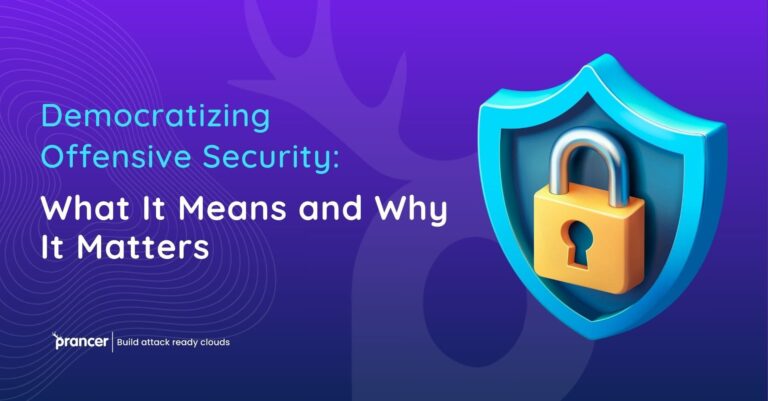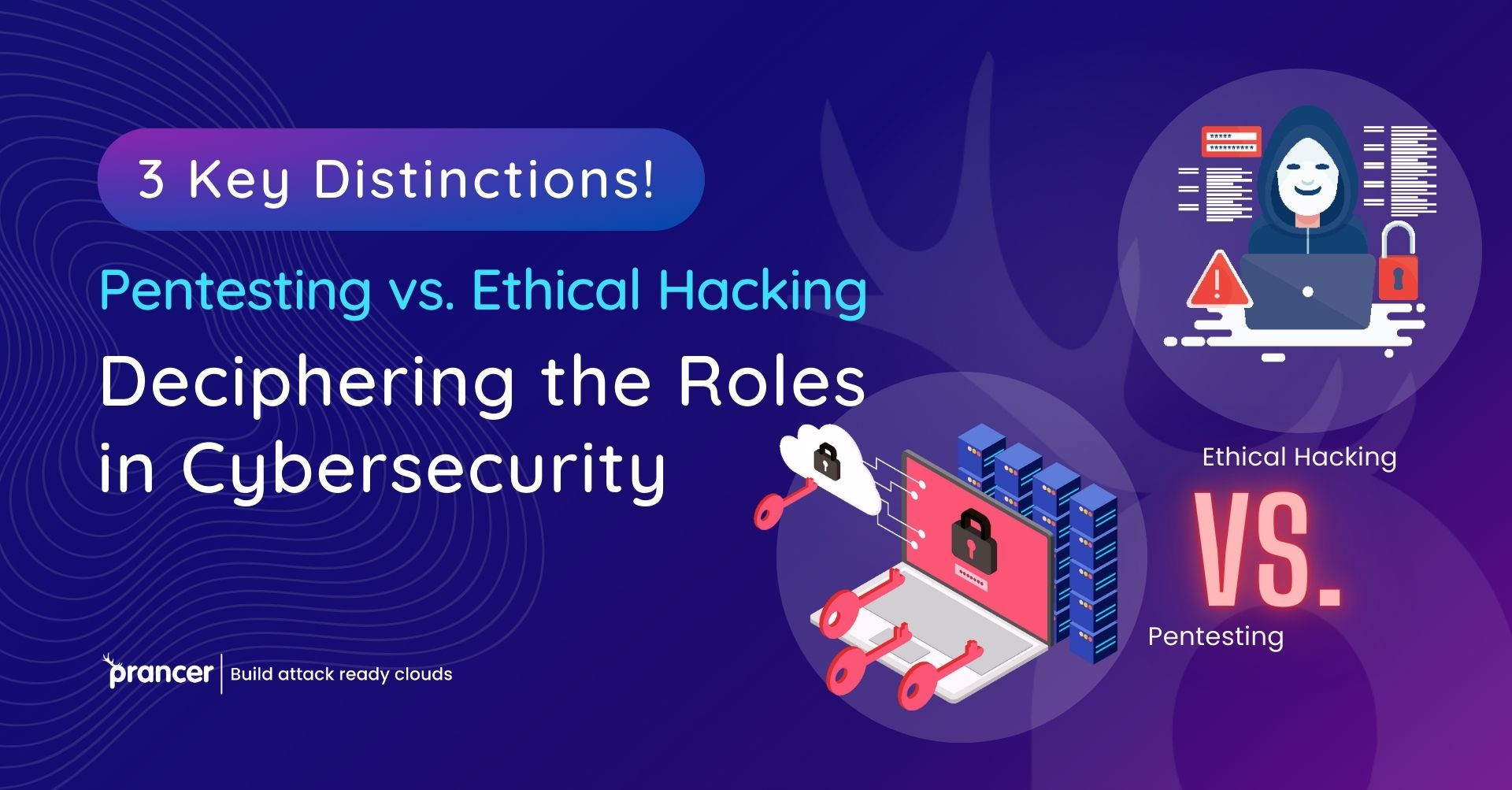Pentesting vs. Ethical Hacking: Deciphering the Roles in Cybersecurity (3 Key Distinctions!)


Pentesting vs. Ethical Hacking: Deciphering the Roles in Cybersecurity (3 Key Distinctions!)
In the complex field of cybersecurity, a clear understanding of the contrasts between pentesting vs ethical hacking is vital. Though often used synonymously, these terms represent different scopes and methodologies in security testing. This blog post aims to elucidate the distinctions between pentesting vs ethical hacking, focusing on the role of Prancer’s automated penetration testing technology.
Within the complex context of cybersecurity, Prancer’s automated penetration testing technology represents an illuminating direction in which to differentiate between pentesting and ethical hacking. The two play crucial parts in security testing, but automated penetration testing notably simplifies and improves the speed of the pentesting process. This blog post takes a deep dive into how to understand the approach Prancer Advanced Technology changes pentesting compared with classical ethical hacking techniques.
Pentesting and honest hacking both have Prancer as a big name. Leveraging automated penetration testing, Prancer’s technology is agile and precise in finding vulnerabilities. By improving the efficiency of pentesting vs moral hacking activities, they help organizations defend robust security postures.
Prancer’s state-of-the-art technology and automated penetration testing are key components in closing the gap between pentesting vs moral hacking. With it, organizations can make rapid and thorough security assessments. This kind of simulated attack lets you continuously validate and refine your security measures.
Innovation, not disruption Prancer’s innovative approach fits well with both the pentest and ethical hacking paradigms. Its automated penetration testing tools also provide information and capabilities not previously possible, changing the way organizations combat security threats.
Prancer’s innovative technology is an excellent case study of automated pentesting, and has become one of the hottest trends in cybersecurity. It integrates the concepts of pentesting and ethical hacking into a flexible security assessment model. Automating complicated tasks, they make vulnerabilities visible much more quickly. This leads to fast response and fortification. This does not replace human expertise but goes one step further, freeing cyber security experts to apply their skills directly in areas of planning and defense. Combatting the volatile field of cyber threats requires a stable and proactive secretariat, using technology instead of intuition. Prancer is reshaping the cybersecurity paradigm with innovative, more affordable, and stronger solutions for organizations of all sizes.
In the complex world of online safety, telling apart pentesting and ethical hacking is important for good computer defense. Pentesting, or penetration testing, is about looking for weaknesses in certain computer systems by using both automated and manual methods. But ethical hacking means more than just finding weaknesses. It also involves looking at bigger security issues to make an organization’s whole protection system better.
Prancer’s automatic attack testing tool shows a big change in this area, joining together the difference between pentesting and ethical hacking. It makes it faster and better at finding weaknesses in security. It’s easier than old ways of doing things. This technology speeds up the process of ethical hacking and adds to its big picture. It helps cybersecurity workers concentrate on planning strong defenses against online attacks. Prancer’s new system for automatic penetration testing shows a clever way to handle cybersecurity. It changes and improves as the fast-moving world of digital danger does so too.
In the complex domain of cybersecurity distinguishing pentesting from ethical hacking is something that must be done within a defense strategy. Although these concepts are used synonymously, they reflect two different approaches to security testing. By shedding light on the differences between pentesting and ethical hacking, as well as explaining how Prancer’s APT technology is transforming this line of work.
Automated Penetration Testing: Redefining Cybersecurity Paradigms
Prancer’s pioneering work on APT marks a fundamental change in approaches to cybersecurity. Therefore, APT automatizes the whole pentesting procedure to provide unmatched effectiveness and accuracy in detecting vulnerabilities making it an integral part of modern security mechanisms.
Pentesting vs Ethical Hacking: Understanding the Key Differences
Scope and Focus:
Pentesting: In these, it is aimed at simulation of attacks to understand vulnerabilities in certain systems or applications using automatic and manual approaches.
Ethical Hacking: Incorporates a wider scope incorporating pentesting, vulnerabilities assessment and threat analysis that is aimed at improving the general security of an organization.
Methodology:
Pentesting: Uses custom tools, approaches that are utilized in the pursuit of exploitation and impact analysis, focusing on targeted attacks.
Ethical Hacking: It Performs a detailed security review on all aspects of the system including penetration testing, code analysis and social engineering seeking vulnerabilities throughout entire digital infrastructure.
Objective:
Pentesting: Attempting to emulate an attacker in order to detect weaknesses and propose practical remedial measures.
Ethical Hacking: Tries to evaluate and refine comprehensive security practices as well implement a culture of indispensability.
Prancer’s Function as a Mediator between Pentesting and Ethical Hacking
Prancer has established itself as a major player in not only pentesting, but also ethical hacking. Its APT technology improves the efficiency of conventional security testing processes by providing agile and precise vulnerability detection. This combination strengthens organizational security posture by blending the accuracy of pentesting with the all-encompassing nature that defines ethical hackers.
Automated Penetration Testing through the Prancer Advantage
In terms of pentesting and ethical hacking, the APT tools used by Prancer are also quite innovative. These instruments provide knowledge and functions that were previously impossible, enabling organizations to treat security risks differently.
Cybersecurity Innovation with Prancer’s Technology.
Prancer’s APT technology shines bright among the stars of cyber security. It helps to speed up detection of the weaknesses, which in turn improves the response time and subsequent measures positive reinforcement. This method does not replace the human component but supplements it, making cybersecurity experts more strategic in planning and defense.
Prancer’s stable and proactive solutions in fighting cyber threats.
In the dynamic environment of cyber threats, Prancer’s APT technology offers stable proactive solutions. It outruns intuition with technology, redefining cybersecurity through constantly innovating dynamic cost-effective and robust solutions for organizations of all scales.
Automated Penetration Testing: A Game-Changer in Cybersecurity
The Prancer APT tool is a major breakthrough in cybersecurity, combining the differences between pentesting and ethical hacking. It speeds and upgrades the identification of security vulnerabilities, downsizing ethical hacking procedures thereby creating an informed overall portrait.
Prancer’s APT is empowering cybersecurity teams.
Using Prancer’s APT technology, cybersecurity teams are able to concentrate on the proactive development of robust defense tactics for online attacks. Through the elimination of technical complications surrounding vulnerability detection, it provides freed up human force to address security planning and implementation at a more advanced level.
APT: A Strategic Tool in Cybersecurity
APT is not just a technical fix; it’s also an evolving strategic platform that adjusts to the everchanging digital threat terrain. This evolutionary character can be seen in the way Prancer approaches APT, its solutions expanding harmoniously with cybersecurity threats.
Automated Penetration Testing: The Future of Cybersecurity
With the fast-changing nature of digital threats, this places APT ahead in solutions for cybersecurity. Since Prancer is committed to the advancement of APT technology, it stays an important means used in securing digital structures.
APT in Comprehensive Security Strategies
Incorporating APT into the overall security strategies makes much easier for an organization to perform preemptive mitigation measures in response to potential vulnerabilities. This integration is critical to the development of a robust and agile cybersecurity framework.
Prancer’s automated solutions for boosting cybersecurity.
The APT solutions provided by Prancer are a step towards the future in cyber security with the advance automated tools which redefine both boundaries of pentesting and ethical hacking. With cybersecurity as a key pillar of integral digital functions, Prancer’s APT technology will continue to dictate secure futures going forward.
A comparison of pentesting vs hacking ethically is key to understanding how they perform different roles in cyber security. Prancer’s automated penetration testing is complementary to these methodologies. If combined, the organization will be better positioned to guard its digital assets from threats and attacks With the lines between pentesting and ethical hacking blurring, Prancer’s tech is a clear pathway down which businesses can confidently follow with ease as security evolves.
